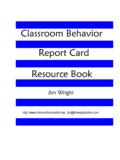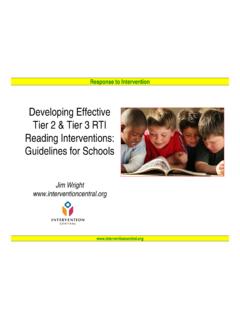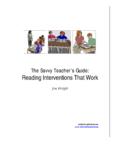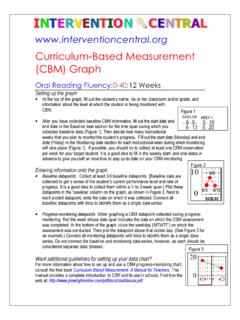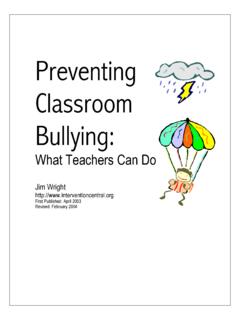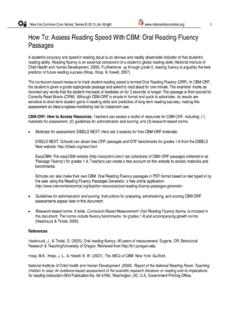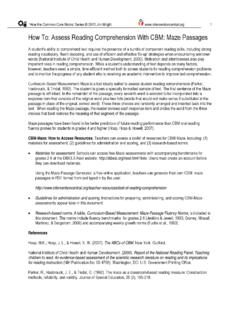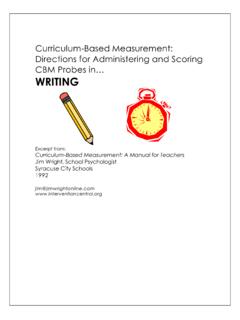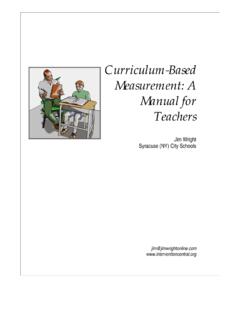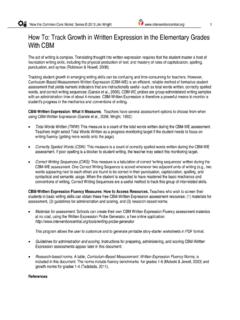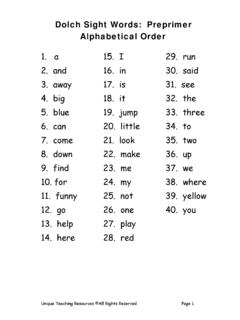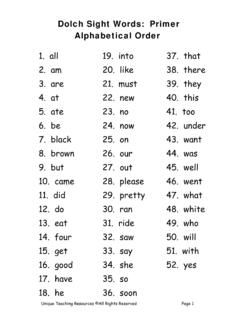Transcription of Classroom Progress-Monitoring Methods Checklist
1 10. Classroom Progress-Monitoring Methods Checklist Whenever teachers put an academic or behavioral intervention in place for a student, they will also want to collect Classroom Progress-Monitoring data to judge whether that intervention is effective (Witt, VanDerHeyden, &. Gilbertson, 2004). For teachers, the six most frequent intervention targets are the following: 1. Academics: Acquisition of basic skills 2. Academics: Fluency in basic skills 3. Academics: Complex skills 4. Academics: Survival skills 5. Behaviors 6. Homework The table below is designed as a' look-up' resource to help instructors quickly to select appropriate monitoring tools to track the success of academic and behavioral interventions. Under each intervention target are listed one or more data sources that can measure the target--along with information about how to make or find examples of recommended 1. Academics: measurement Basic Skills Acquisition What to assess: Basic academic skills are those 'building-block' skills that are the foundation for more advanced learning.
2 When students are just acquiring basic skills, they often are expected to learn a finite set of items--such as letter sounds, multiplication math-facts 0-9, dolch pre- primer sight word list, or 50 vocabulary terms necessary for success in a biology course. At this acquisition stage of learning, the teacher's measurement objective is to monitor which items the student has mastered from the larger set. How to assess and where to find materials: Cumulative mastery log. The simplest way for the teacher to track which items the student has learned from a larger pool is to maintain a cumulative mastery log. First, the teacher develops objective guidelines for judging that a student has mastered an item: , "to know a math-fact, the student must answer the fact correctly from a flash-card within 3 seconds and repeat the feat twice in a row during a session". Then the teacher conducts a baseline assessment. That is, the instructor (1) reviews with the student all items in the larger pool ( , letters.)
3 Multiplication math-facts 0-9, etc.) Using the previously developed guidelines for judging mastery, the teacher (2). identifies and (3) records those items that the student already knows at baseline. Then during the intervention, whenever the student masters an additional item, the teacher logs the item and date acquired. Over time, this log becomes a cumulative, date-stamped record of items acquired by the student. A tutorial on setting up and using a cumulative mastery log is presented elsewhere in this handout (How To: Use the Cumulative Mastery Log to Record progress in the Acquisition Stage of Learning) along with a sample form. Jim Wright, Presenter 10. 11. 2. Academics: Fluency in Basic Skills What to assess: When a student has acquired basic academic skills, the next goal is often to build fluency in those skills. Examples of fluency goals are increasing a student's oral reading speed and working toward automatic recall of math-facts.
4 In this fluency stage of learning, the instructor's measurement objective is to continue to monitor accuracy while also tracking increasing speed of performance. How to assess and where to find materials: Curriculum-based measurement. A very useful way to assess a student's growing fluency (as well as accuracy) in foundation academic skills is via curriculum-based measurement (CBM) -- a family of quick assessments of basic academic skills. While CBM covers a wide range of different assessments, all are brief; timed; use standard procedures to prepare materials, administer, and score; and include decision rules to help educators to make appropriate instructional decisions (Hosp, Hosp & Howell, 2007). Examples of CBM include oral reading fluency (1-minute passages that the student reads aloud) and math computation (2-minute math-fact worksheets with the student receiving credit for number of digits computed correctly).
5 3. Academics: Complex Skills What to assess: Teachers often find that they must evaluate a student on higher-level academic skills that are multi-dimensional and complex (Moskal, 2000). For example, the Common Core ELA Standard for grade 5- speaking and listening ( ) sets the expectation that, in collaborative discussions, the student will come prepared, participate, engage in appropriate turn-taking and follow other discussion rules, etc. Similarly, a standard for grade 4 writing ( ) presents as a goal that the student will write an opinion essay supporting a specific point of view that includes specific elements such as introductory and concluding statements and supporting details. In both examples, a student may show evidence of at least partial fulfillment of some elements within the standard. So teachers need a flexible evaluation format for rating complex academic skills, one that can handle several dimensions simultaneously, while defining for each dimension a sliding-scale, or continuum, for rating success.
6 How to assess and where to find materials: Rubrics. Rubrics are well-suited for measuring a student on complex tasks. In a rubric, the teacher defines the categories that make up the important dimensions of a task, develops exemplars representing mastery for each dimension, and creates a rating scale to be used in evaluating a particular student's work for each dimension (Schafer, Swanson, Bene', & Newberry, 2001). A detailed description of how to create rubrics for Classroom use can be found elsewhere in this handout (How To: Use Rubrics in Student Assessment ) on student assessment. Jim Wright, Presenter 11. 12. 4. Academics: Survival Skills What to assess: Academic survival skills are those global 'academic enablers'--such as time management, study skills, homework completion, note-taking--required to support a strong academic performance (DiPerna, 2006). How to assess and where to find materials: Academic survival skills checklists.
7 A global academic survival skill ( , study skills) can be made measureable by dividing that overarching category into specific, observable component sub-skills ( , maintains clear work space for study; creates a study schedule; allocates adequate time each day for study) to create a Checklist . Each element of that Checklist can then be verified through direct observation, student interview, and/or examination of student work products. A series of academic survival skills checklists appears elsewhere in this handout (How To: Use Checklists to Measure Academic Survival Skills) on student assessment. Teachers can also create their own customized checklists using a free online application, the Academic Survival Skills Checklist Maker: 5. Behaviors What to assess: Classroom behaviors are specific, observable behaviors that relate to such categories as general conduct ( , remaining in seat, calling out), compliance ( , following teacher directives); and academic readiness and engagement ( , paying attention to the teacher during a lesson, completing independent seatwork, bringing work materials to class).
8 How to assess and where to find materials: Behavior report card. A behavior report card is a type of rating scale that the teacher fills out on a regular basis-- , daily-- to rate targeted student behaviors (Riley-Tillman, Chafouleas, & Briesch, 2007). Behavior report cards have several advantages: They are quick to complete, can be customized by the teacher to measure any observable behavior, and are an excellent vehicle for communicating Classroom behavioral expectations to students and parents. A sample behavior report card (RTI Daily Behavior Report: Guidelines for Use) appears elsewhere in this handout. Teachers can create their own behavior report cards using the Behavior Report Card Maker, a free online application: Frequency count. In a frequency count, the teacher keeps count of the number of times that the student engages in a target behavior ( , number of call-outs; episodes of non-compliance with teacher requests) during an observation period.
9 If frequency-count data are collected across multiple observation periods of the same duration, the teacher can directly compare the data across those observations to look for trends of improvement. A sample observation sheet for collecting frequent-count data (Student Self- monitoring : Frequency Count). appears later in this handout. Jim Wright, Presenter 12. 13. 6. Homework What to assess: Homework can be evaluated in a number of ways. Depending on the nature of the student's presenting problem(s), the teacher may use one or more of the data sources below to track homework timeliness, completion, accuracy, and/or quality. How to assess and where to find materials: Existing data. If the teacher's focus is on getting homework turned in reliably and on time, that instructor can use existing data, such as gradebook information about homework submission, to monitor this intervention goal. Quality: Percentage of work attempted/grade.
10 If the teacher is monitoring the quality of the submitted homework, two simple but useful metrics are (1) an estimate of the amount of work attempted (presented as a percentage of the entire assignment) and (2) homework grades. Quality: Rubric. Because some homework assignments ( , term paper; PowerPoint presentation) are complex and must be rated across several dimensions, the teacher may choose the rubric as an evaluation tool. A detailed description of how to create rubrics for Classroom use can be found elsewhere in this handout. References DiPerna, J. C. (2006). Academic enablers and student achievement: Implications for assessment and intervention services in the schools. Psychology in the Schools, 43, 7-17. Hosp, , Hosp, J. L., & Howell, K. W. (2007). The ABCs of CBM. New York: Guilford. Moskal, Barbara M. (2000). Scoring rubrics: what, when and how?. Practical Assessment, Research & Evaluation, 7(3). Retrieved June 3, 2013 from Riley-Tillman, T.
